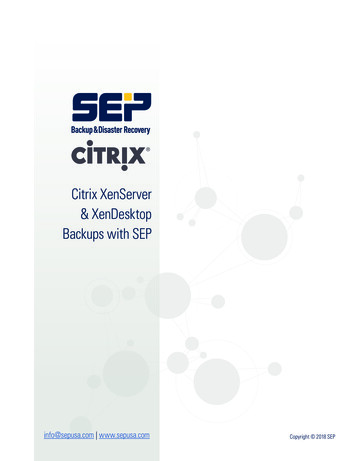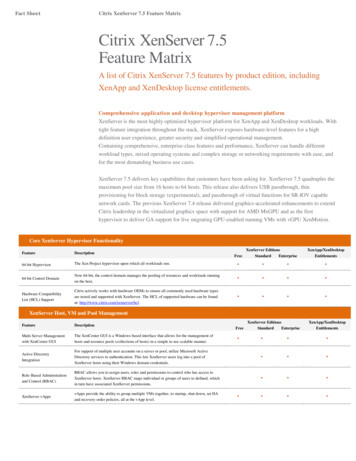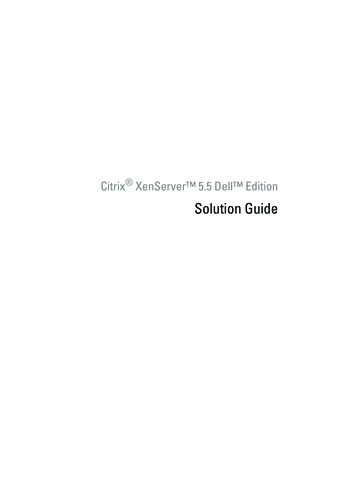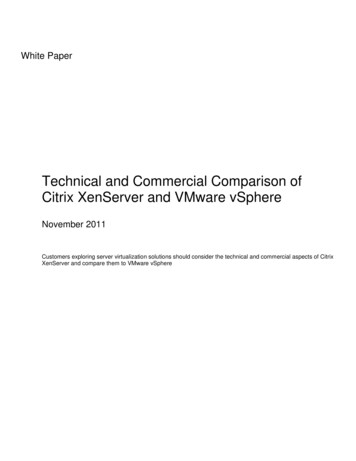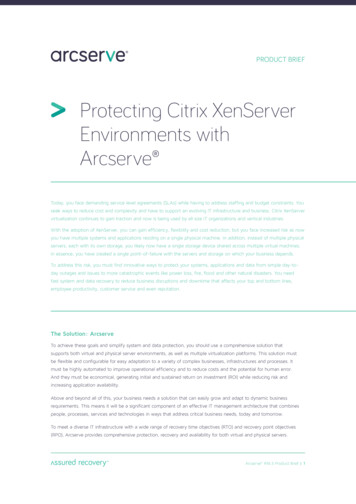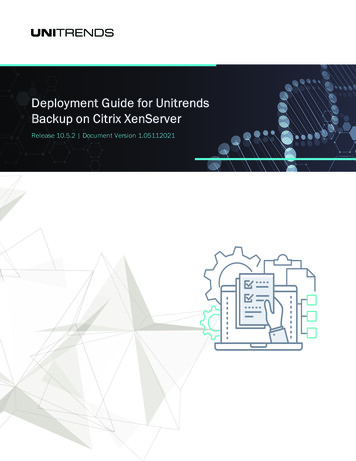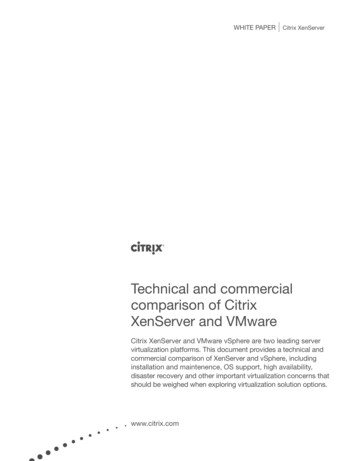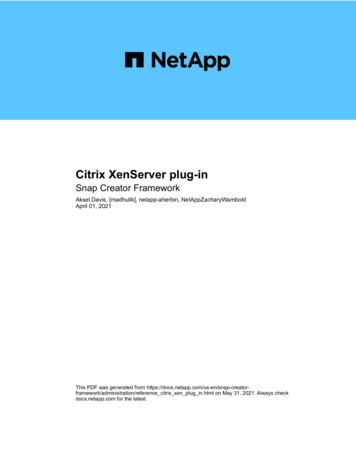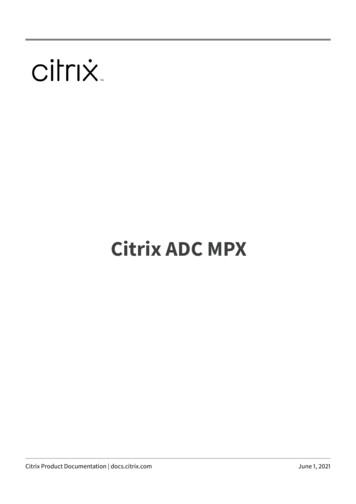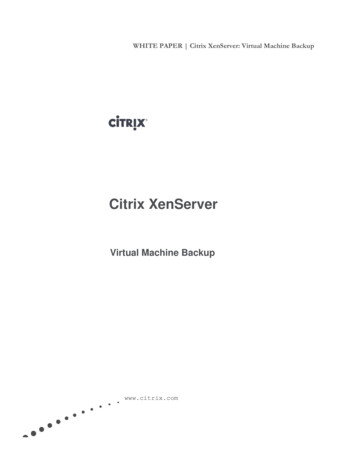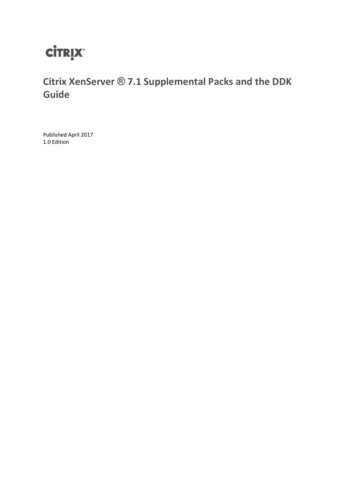
Transcription
Citrix XenServer 7.1 Supplemental Packs and the DDKGuidePublished April 20171.0 Edition
Citrix XenServer 7.1 Supplemental Packs and the DDK GuideCopyright 2017 Citrix Systems. Inc. All Rights Reserved.Version: 7.1Citrix, Inc.851 West Cypress Creek RoadFort Lauderdale, FL 33309United States of AmericaDisclaimersThis document is furnished "AS IS." Citrix, Inc. disclaims all warranties regarding the contents of this document,including, but not limited to, implied warranties of merchantability and fitness for any particular purpose. Thisdocument may contain technical or other inaccuracies or typographical errors. Citrix, Inc. reserves the right torevise the information in this document at any time without notice. This document and the software describedin this document constitute confidential information of Citrix, Inc. and its licensors, and are furnished under alicense from Citrix, Inc.Citrix Systems, Inc., the Citrix logo, Citrix XenServer and Citrix XenCenter, are trademarks of Citrix Systems, Inc.and/or one or more of its subsidiaries, and may be registered in the United States Patent and Trademark Officeand in other countries. All other trademarks and registered trademarks are property of their respective owners.TrademarksCitrix XenServer XenCenter
Contents1. Introduction . 11.1. What's new in XenServer 7.1 . 11.2. Purpose of supplemental packs . 11.3. Why a separate DDK? . 11.4. Benefits . 21.5. What should (not) be in a supplemental pack? . 22. Getting started . 42.1. Introduction . 42.2. Installing XenServer . 42.3. Installing XenCenter . 42.4. Connect XenCenter to the XenServer host . 42.5. Importing the DDK VM through XenCenter . 42.6. Importing the DDK VM using the CLI . 52.7. Using the DDK VM . 52.8. Adding Extra Packages to the DDK VM . 52.9. Accessing the DDK VM console from the host console . 53. Building the example packs . 74. Installing supplemental packs . 94.1. At installation time . 94.2. On a running host . 94.3. Driver-specific considerations . 105. Producing driver RPMs . 115.1. Directory structure . 115.2. Makefile variables . 115.3. Creating the kernel module specification file . 115.4. Building the modules . 125.5. Including driver RPMs in supplemental packs . 125.6. Format for releasing drivers . 12iii
5.7. Releasing multiple drivers in a single pack . 126. Creating a supplemental pack . 146.1. Syntax of build-update . 146.1.1. Name, vendor, and version information . 146.1.2. Declaring Pack dependencies . 146.2. A brief example . 146.3. Adding files to Server Status Reports . 146.3.1. Extending an existing category . 156.3.2. Adding new categories . 176.4. Automating pack installation at XenServer installation time . 176.4.1. Including an answerfile on the XenServer installation ISO . 177. Rules and guidelines . 197.1. Kernel modules . 197.2. Post-install scripts . 197.3. Handling upgrades . 197.3.1. Pack upgrade during a XenServer upgrade . 207.3.2. Pack upgrade on an existing XenServer installation . 207.4. Uninstallation . 207.5. Building packs in existing build environments . 207.6. Packaging driver firmware . 217.7. Versioning . 217.7.1. Supplemental packs . 217.7.2. Kernel modules . 217.8. Packages compiled by, but not in, XenServer . 227.9. Requirements for submission of drivers for inclusion in XenServer . 227.10. Does XenServer already include a driver for my device? . 238. Testing & certification . 248.1. Testing overview . 248.2. Testing scope . 248.3. Running tests . 24iv
8.4. Tests that require an integrated build . 258.5. Certification & support . 258.5.1. Drivers . 258.5.2. Userspace software . 259. Additional Resources . 279.1. Introduction . 279.2. Xen API plug-ins . 279.3. XenCenter plug-ins . 279.4. XenServer SDK . 27v
Chapter 1. IntroductionSupplemental packs are used to modify and extend the functionality of a XenServer host, by installing softwareinto the control domain, dom0. For example, an OEM partner might wish to ship XenServer with a suite ofmanagement tools that require SNMP agents to be installed, or provide a driver that supports the latesthardware. Users can add supplemental packs either during initial XenServer installation, or at any timeafterwards. Facilities also exist for OEM partners to add their supplemental packs to the XenServer installationrepositories, in order to allow automated factory installations.1.1. What's new in XenServer 7.1XenServer has had several different mechanisms for updating a host, notably: Hotfix Driver Disk Supplemental PackIn XenServer 7.1, Citrix is unifying the customer experience by combining these different types of updates intoa single package, called an “Update package”. An Update package consists of an ISO with signed RPMs andmetadata and offers the following advantages over the previous Driver Disk/Supplemental Pack format: GPG Signed RPMs/Metadata – from XenServer 7.1 onwards, Citrix is making it a requirement that all updatesbe signed by a key, with the public part of the key being included on the system. This ensures that customersonly install trusted software via our update APIs. Improved APIs – the new update package can be uploaded directly with our API using the following calls: Update-upload Update-precheck Update-apply Update-list Uploads to a VDI – in order to support large updates, the upload API will upload the package to a VDI. Thismeans that updates do not require the customer to have space in dom0 to upload them to first. Unified update format – migrating to a single Update package should improve the customer experienceinvolved in applying updates.1.2. Purpose of supplemental packsSupplemental packs consist of a number of packages along with information describing their relationship to otherpacks. Individual packages are in the Red Hat RPM file format, and must be able to install and uninstall cleanlyon a fresh installation of XenServer.Packs are created using the XenServer Driver Development Kit (DDK). This has been extended to not only allowthe creation of supplemental packs containing only drivers (also known as driver disks), but also packs containinguserspace software to be installed into dom0.Examples and tools are included in the XenServer DDK to help developers create their own supplemental packs.However, for partners wishing to integrate pack creation into their existing build environments, only a few scriptstaken from the DDK are necessary.1.3. Why a separate DDK?XenServer is based on a standard Linux distribution, but for performance, maintainability, and compatibilityreasons ad-hoc modifications to the core Linux components are not supported. As a result, operations thatrequire recompiling drivers for the Linux kernel require formal guidance from Citrix, which the DDK provides. In1
addition, the DDK provides the necessary compile infrastructure to achieve this, whereas a XenServer installationdoes not.XenServer integrates the latest device support from kernel.org on a regular basis to provide a current set ofdevice drivers. However, assuming appropriate redistribution agreements can be reached, there are situationswhere including additional device drivers in the shipping XenServer product, such as drivers not availablethrough kernel.org, or drivers that have functionality not available through kernel.org, is greatly beneficial tojoint customers of Citrix and the device manufacturer. The same benefits can apply by supplying device driversindependent of the XenServer product.In addition, components such as command line interfaces (CLIs) for configuring and managing devices arealso very valuable to include in the shipped XenServer product. Some of these components are simple binaryRPM installs, but in many cases they are combined with the full driver installation making them difficult orimpossible for administrators to install into XenServer. In either case including current versions of everything theadministrator requires to use the device on XenServer in a supplemental pack provides significant value.The DDK allows driver vendors to perform the necessary packaging and compilation steps with the XenServerkernel, which is not possible with the XenServer product alone. Supplemental packs can be used to package upboth drivers and userspace tools into one convenient ISO that can be easily installed by XenServer users.1.4. BenefitsSupplemental packs have a variety of benefits over and above partners producing their own methods forinstalling add-on software into XenServer: Integration with the XenServer installer: users are prompted to provide any extra drivers or supplementalpacks at installation time. In addition, on upgrade, users are provided with a list of currently installed packs,and warned that they may require a new version of them that is compatible with the new version of XenServer. Flexibility in release cycles: partners are no longer tied to only releasing updates to their add-on softwarewhenever new versions of XenServer are released. Instead, partners are free to release as often as they choose.The only constraint is the need to test packs on the newest version of XenServer when it is released. Integration with Server Status Reports: supplemental pack metadata can include lists of files (or commands tobe run) that should be collected when a Server Status Report is collected using XenCenter. Pack authors canchoose to create new categories, or add to existing ones, to provide more user-friendly bug reporting. Guarantee of integrity: supplemental packs are signed by the creator, allowing users to be certain of theirorigin. Include formal dependency information: pack metadata can detail installation requirements such as whichversions of XenServer the pack can be installed upon. Inclusion in the Citrix Ready catalogue: partners whose supplemental packs meet certain certification criteriawill be allowed to list their packs in the Citrix Ready online catalogue, thus increasing their visibility in themarketplace. Note that partners must become members of the program before their packs can be listed: theentry level category of membership is fee-free.1.5. What should (not) be in a supplemental pack?Citrix recognises that partner organizations can contribute significant value to the XenServer product by buildingsolutions upon it. Examples include host management and monitoring tools, backup utilities, and device-specificfirmware. In many cases, some of these solutions will need to be hosted in the XenServer control domain, dom0,generally because they need privileged access to the hardware.Whilst supplemental packs provide the mechanism for installing components into dom0, pack authors shouldtry to install as little as possible using packs. Instead, the majority of partner software should be placed intoappliance virtual machines, which have the advantage that the operating system environment can be configuredexactly as required by the software to be run in them.The reasons for this stipulation are:2
XenServer stability and QA: Citrix invests considerable resources in testing the stability of XenServer. Significantmodifications to dom0 are likely to have unpredictable effects on the performance of the product, particularlyif they are resource-hungry. Supportability: the XenServer control domain is well-known to Citrix support teams. If it is heavily modified,dom0 becomes very difficult to identify whether the cause of the problem is a component of XenServer, or dueto a supplemental pack. In many cases, customers may be asked to reproduce the problem on an unmodifiedversion of XenServer, which can cause customer dissatisfaction with the organization whose pack has beeninstalled. Similarly, when a pack author is asked to debug a problem perceived to be with their pack, havingthe majority of the components of the pack in an appliance VM of known/static configuration can significantlyease diagnosis. Resource starvation: dom0 is limited in memory and processing power. If resource-hungry processes areinstalled by a supplemental pack, resource starvation can occur. This can impact both XenServer stability andthe correct functioning of the supplemental pack. Note that Citrix does not advise increasing the number ofdom0 vCPUs. Security: XenServer dom0 is designed to ensure the security of the hosts that it is installed on to. Any securityissues found in software that is installed into dom0 can mean that the host is open to compromise. Hence, thesmaller the quantity of software installed into dom0 by a pack, the lower the likelihood that XenServer hostswill be compromised due to a flaw in the software of the pack.Partners often ask whether supplemental packs can include heavy-weight software, such as the Java runtimeenvironment, or a web server. This type of component is not suitable for inclusion in dom0, and should insteadbe placed in an appliance VM. In many cases, the functionality that is desired can be achieved using such anappliance VM, in conjunction with the Xen API. Citrix can provide advice to partners in such cases.3
Chapter 2. Getting started2.1. IntroductionThis chapter describes how to setup a base XenServer system, running a DDK Virtual Machine (VM), for examiningthe examples provided in this document, and for use in the development of supplemental packs. Partners whowish to construct supplemental packs as part of their own build systems should consult the appropriate section,later in this document.The high-level process of setting up a DDK VM to create a supplemental pack is:1. Obtain matching XenServer product and DDK build ISOs.2. Install XenServer onto a host server.3. Install the XenCenter administrator console onto a Windows-based machine.4. Use XenCenter to import the DDK onto the XenServer host as a new virtual machine.2.2. Installing XenServerInstalling XenServer only requires booting from the CD-ROM image, and answering a few basic questions. Aftersetup completes, take note of the host IP address shown, as it is required for connection from XenCenter.Note:Intel VT or AMD-V CPU support is required to run Windows guests, but is not required inorder to use the DDK, nor for testing drivers in the XenServer control domain (dom0).2.3. Installing XenCenterXenCenter, the XenServer administration console, must be installed on a separate Windows-based machine.Inserting the XenServer installation CD will ru
Citrix recognises that partner organizations can contribute significant value to the XenServer product by building solutions upon it. Examples include host management and monitoring tools, backup utilities, and device-specific firmware. In many cases, some of these solutions will need to be hosted in the XenServer control domain, dom0,
